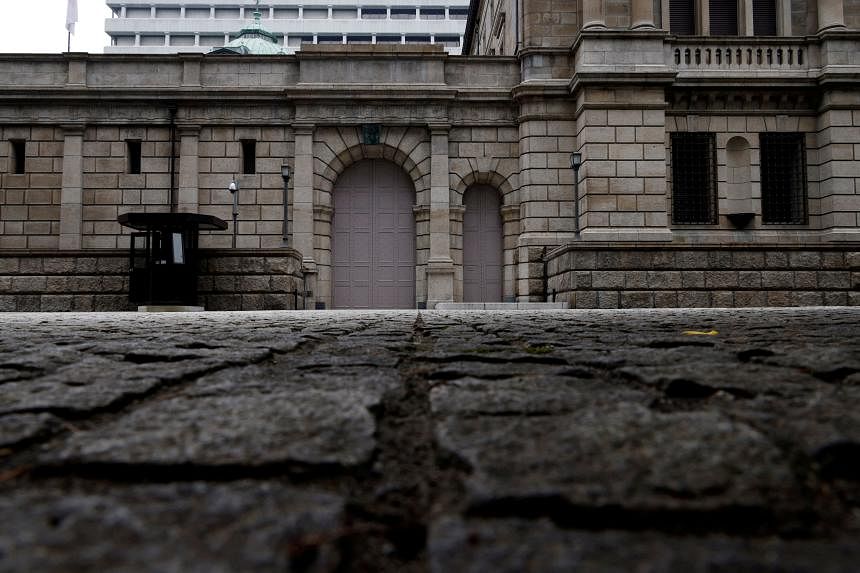TOKYO – A dialling back of massive Bank of Japan bond purchases and even a tweak to yield-curve control would fail to solve the liquidity drought in the country’s debt market next year, according to investors.
Only an overhaul of the entire framework of policy easing would lead to a sustainable improvement in the liquidity strains, said Mitsubishi UFJ Kokusai Asset Management Co. A BOJ survey measure of investors’ perception of Japan’s bond market functioning has fallen to a record low.
The BOJ ramped up bond purchases so far this year to the most since 2017, in a bid to fend off speculative attacks on its curve control policy, which keeps 10-year yields capped at 0.25 per cent. It bought ¥95 trillion (S$940 billion) of Japanese government bonds through November, according to central bank data compiled by Bloomberg.
But its outsized presence in the market – it owns about half of all government bonds – has dried up trading and distorted the yield curve, limiting the potential for regular buying and selling activity for dealers and investors alike.
“The bond market is very vulnerable now,” said Nobuyasu Atago, chief economist at Ichiyoshi Securities Co. “The BOJ’s large-scale bond buying is hurting market functioning and the risk of a surge in yields is rising. The chance of a policy change to address the issues will only grow as time elapses.”
The central bank’s quarterly survey on market functioning, which asks lenders, insurance companies and asset managers mainly about liquidity, showed 52 per cent of respondents said it was low with just 1 per cent opting for high. The difference between the two fell to the lowest in the central bank data going back to 2015.
Japan’s bond market came under speculative attack this year as funds bet soaring global inflation would lead to a tweak to policy. But officials pushed back with a series of unprecedented asset purchases which kept a lid on yields and the BOJ steadfastly stood by its policy of rock-bottom interest rates.
Defense measures included daily operations that offer to buy unlimited amounts of 10-year notes and futures-linked securities at a fixed rate of 0.25 per cent as well as scheduled and unscheduled purchases of bonds of all maturities at market yields.
But the sheer scale of these steps make normal market functioning impossible and it’s a common occurrence for the benchmark 10-year note not to trade at all some days. In recent months the BOJ’s holdings of benchmark debt has even briefly exceeded the amount outstanding, a phenomenon made possible by the apparent side effects of the central bank’s lending of the securities.
The BOJ has recognized the problem and taken some steps to improve liquidity, such as making it easier for traders to borrow bonds from it. But more is required according to market participants.
“I hope the BOJ will realize soon that it’s destroying the bond market,” said Ayako Sera, a strategist at Sumitomo Mitsui Trust Bank Ltd. in Tokyo. “It could at least stop conducting the fixed-rate operation every day once the Fed stops hiking rates.”
Investors hoping for a significant shift from the central bank noted with interest a recent call for a policy review by new board member Naoki Tamura. But Governor Haruhiko Kuroda said subsequently that the benefits of monetary easing are exceeding its costs and it’s too early to start examining the specifics of its policy.
Kuroda has long cited the joint statement issued by the BOJ and government in January 2013 on the inflation goal as a justification for his massive easing program, but Deputy Chief Cabinet Secretary Seiji Kihara said that the government may look to reach a new accord.
“The problem is the entire framework of the BOJ’s easing,” said Akio Kato, general manager of strategic research and investment at Mitsubishi UFJ Kokusai in Tokyo. “Tweaks such as a wider trading band or targeting a different tenor would only see limited improvement in liquidity and we would only return to a similar situation after a while.”
Still, easing upward pressure on local yields as overseas bonds rally will give room for the BOJ to at least cut back on its debt purchases.
“I expect the BOJ to slow bond purchases,” said Kokusai’s Kato. “But, any resultant improvement in liquidity would prove to be fleeting.” BLOOMBERG

